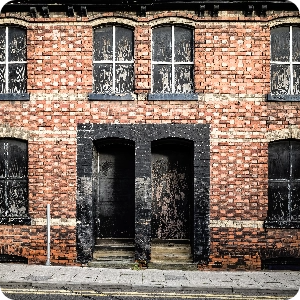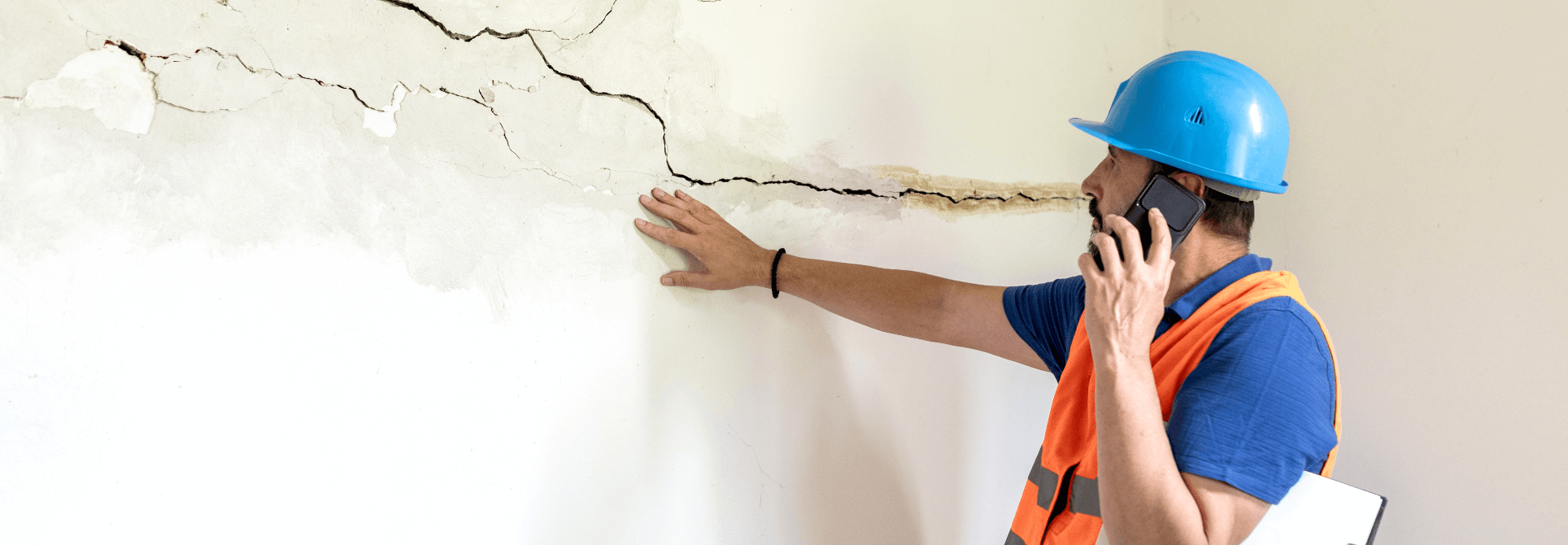06 AUG 2025
5 MIN
READ
As a landlord, your property is more than just a building - it’s a valuable investment. But, like any investment, it comes with its own set of challenges. One of the biggest risks is potential damage to your property.
Whether it’s unexpected structural issues, vandalism, or natural disasters, there are many ways your property can be affected. That’s why it’s important to understand the different types of damage that could occur, so you can be prepared and protect your investment.
What types of damage can affect commercial properties?
Structural damage
Structural damage can threaten the safety and stability of a building. But what causes it? Common sources include natural disasters, poor construction, or the gradual wear and tear that occurs as materials age over time.
Vandalism and theft
Vandalism and theft are deliberate acts that can cause serious headaches for landlords and commercial properties. From broken windows to stolen equipment, these incidents not only lead to costly repairs but can also disrupt your operations and damage your property’s reputation.
Tenant-caused damage
Tenant-caused damage includes any harm done by tenants, whether it's accidental or intentional. To avoid conflicts later, it’s a good idea to lay out clear guidelines early on. This way, everyone knows what's expected of them from the beginning.
Wear and tear vs. insurable damage
It’s important for landlords to understand the difference between normal wear and tear and insurable damage. Wear and tear refer to the natural deterioration that happens over time, like faded paint or minor scuffs. This type of damage usually isn’t covered by insurance.
Insurable damage, on the other hand, involves significant damage caused by accidents, disasters, or vandalism that can be claimed on your insurance policy.
Knowing the difference between these helps to clarify your responsibilities and protect your investment.
Steps to take after discovering damage
Assess the extent of the damage
After discovering damage, the first steps is to assess how serious it is. Inspect the impacted areas to figure whether it’s minor damage, or something more concerning. This will help you decide what actions to take next, and whether or not you’ll need to get professional help.
Don’t forget to take photos and make notes – this can help later should you need to make a claim.
Ensure the property is safe
Safety should always be your top priority, so, investigate whether the damage poses any harm or risk to tenants or others in the building. Remember, it’s your responsibility to take swift action and secure the property. This may include restricting the damaged area, closing off utilities, or even temporarily evacuating the building if necessary.
Keeping everyone safe not only protects lives but also helps minimise your liability as a landlord.
Notify your insurer
Once you’ve assessed the damage and taken the necessary safety precautions, it’s time to notify your insurance provider. Reach out to them as soon as possible to report the situation and kickstart the claims process. The sooner you make contact, the better your chances of securing the coverage you need. Prompt communication can make a big difference in how your claim is handled, so don’t delay!
Document the damage
Clearly document the details of the property damage, not only for your records, but also for any insurance claims or disputes that may arise.
Here’s how:
Take detailed photos
Use high-resolution images when possible, and ensure they are clear – try to avoid blurry photos or ones with obstructions.
Write descriptive notes
Alongside your photos, make detailed notes about the damage. Include specific details like the date of discovery, the nature of the damage, any immediate actions taken, and initial comments about its severity. These notes can help provide context for both insurance and repair purposes.
Keep detailed records
Any communication related to the damage should be documented. This includes emails, texts, or letters with tenants, contractors, or your insurance provider. Maintaining accurate records can help support your case if disputes arise later.
Who is responsible for the repairs - landlord or tenant?
Landlord responsibilities
Landlords are generally responsible for major repairs and maintenance, including:
- Structural integrity – Issues affecting the building’s foundation, roof, or walls.
- System repairs – Fixing faults with plumbing, heating, and electrical systems.
- Living standards – Ensuring that the property remains liveable and safe for tenants.
Tenant responsibilities
Tenants may be responsible for:
- Minor repairs – The ‘everyday’ stuff, like changing light bulbs or maintaining cleanliness.
- Tenant damage to property – Harm or damage resulting from negligence or intentional actions.
- Routine maintenance – Reporting issues in a timely manner to prevent bigger problems later.
When is the tenant liable for damage?
Tenants may be held liable for damages to the property when the damage results from their actions - whether accidental or malicious.
Here are a few examples:
Malicious damage
- Damaging appliances
- Vandalising walls
- Defacing the property
Accidental
- Scuffs and scratches
- Breaking furniture
- Spills and stains
When is the landlord liable for damages?
Landlords may be liable for damages that occur due to structural issues or external factors.
Here's a few examples:
- Structural damage – If a roof leaks due to poor maintenance, and water damages the tenant's belongings, the landlord could be liable for repairs and compensation.
- External damage – If a poorly maintained fixture on the property falls during a storm and damages a tenant’s car, the landlord may be held responsible for the damage.
How to handle insurance claims for commercial property damage
Filing an insurance claim for commercial property damage can be a complex process. However, understanding what your insurer needs, the timeframes for filing, and how to handle disputes can take the headache out of it.
What your insurer needs
When making a claim, your insurance provider will ask for specific documents and evidence to process your request efficiently.
Here’s what you’ll need:
- Claim form
- Repair costs or estimates
- Incident report (if necessary) – includes any police reports or incident reports related to vandalism or theft.
- Documents of damage
- Proof of ownership
- Records of communications – any written communication between tenants, contractors, and any relevant parties that may support your claim.
Timeframes for filing a claim
Notification period
Most policies require you to inform your insurer quickly after discovering damage. Check your policy for specific timelines, which can vary between a few days to a few weeks.
Claim Submission
After notifying your insurer, you usually need to submit your claim within a set period, often within 30 days. Refer to your policy for exact deadlines.
Follow up
Be proactive and follow up with your insurer if you don’t receive timely updates. Open communication can help avoid delays.
What to do if a claim is disputed
- Review the reasons for dispute
- Gather additional evidence to support the claim
- Contact your insurer to discuss further
- File an appeal if necessary
What type of insurance can help cover commercial property damage?

Buildings Insurance
Covers the physical structure of your property against risks like fire, theft, or natural disasters.

Landlord Insurance
Protects landlords against property damage, liability claims, and loss of rental income due to damage.

Business Interruption Insurance
Compensates for lost income and extra expenses if your business operations are halted due to property damage.
How to prevent future damage
Regular inspections and maintenance schedules
A good way to ensure that your tenants are following the rules outlined in the tenancy agreement is to have regular check-ins or inspections. By making these fairly regular, you’ll be able to spot any signs of damage or issues from the get-go – stepping in before things escalate.
However, it’s important to remember that you can’t just drop in on a whim. And keep in mind, a property inspection isn’t just having a look around to make sure the place is tidy and in order.
For more help and tips around scheduling tenant inspections, our guide will help you stay compliant while carrying out your checks.
Security measures to prevent vandalism or theft
It’s worth considering implementing security measures to help protect your property from vandalism and theft (particularly if it’s been a problem in the past):
Install security cameras
Invest in motion sensor lighting
Set up alarm systems
Upgrade to deadbolt locks
Change locks between tenants
Provide tenant guidelines
Clear tenant guidelines are essential for maintaining a positive landlord-tenant relationship and ensuring the property is well cared for. When drafting these guidelines, consider setting out rules and guidance around the following:

Ensure you have the right insurance
When it comes to protecting your property, you want peace of mind that you’ve got the right cover in place – should the worst happen. That’s why it’s a good idea to sit down and read through the options available to you.
As a starting point, here is a breakdown of the insurance types that landlords may use for protection:
This covers physical damage to the building caused by events like fire, vandalism, or natural disasters.
Protects against claims for injuries or damages that occur on the property, such as if a tenant or visitor is injured due to a maintenance issue.
Provides financial protection if the property becomes uninhabitable due to covered damage, ensuring you still receive rental income during repairs.
Specifically covers the structure itself, including fixtures and fittings, against various risks.
If you provide furnishings or appliances, this insurance covers damage to, or theft of, those items.
A specialised policy that combines property and liability coverage tailored for rental properties.
Protect the future of your business
Running a business is hard work, so you want to protect the work you put in to make your business a success. Do a little thing today that can make a big difference to your business tomorrow.
Get AXA Business Insurance and Future You will thank you.
All links are checked and valid at time of publishing, 06 August 2025.
